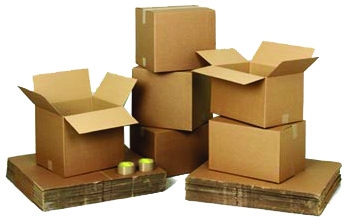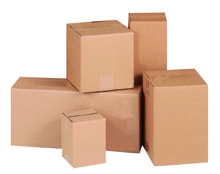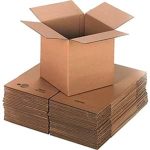
Carrier Rules for corrugated boxes
Corrugated boxes can be used to ship products by air, truck or rail, or by a combination of means for extra fast delivery known as inter-modal overnight. Carriers impose packaging rules in exchange for accepting liability for the articles they transport . Carriers reserve the right to refuse articles they consider inadequately packaged.

If you want your package to be insured by the carrier, you have to follow their rules.
Basic Rules and Regulations to Consider:
|
Max. weight of boxes and content
|
Max. outside dimension Length, Width and Depth added (inches)
|
Min. bursting test, Single wall, Double wall or Solid fiberboard(lbs per sq. in.)
Or Min. puncture test, Triple wall board (in. oz. per in. of tear) |
Min. combined weight of Facing, including Center facings of Double wall and Triple wall board
Or Min. combined Weight of plies, Solid Fiberboard, Excluding adhesives (lbs. per 1,000 sq. ft.) |
| Single Wall Corrugated Fiberboard Boxes | |||
| 20 | 40 | 125 | 52 |
| 35 | 50 | 150 | 66 |
| 50 | 60 | 175 | 75 |
| 65 | 75 | 200 | 84 |
| 80 | 85 | 250 | 111 |
| 95 | 95 | 275 | 138 |
| 120 | 105 | 350 | 180 |
| Double Wall Corrugated Fiberboard Boxes | |||
| 80 | 85 | 200 | 92 |
| 100 | 95 | 275 | 110 |
| 120 | 105 | 350 | 126 |
| 140 | 110 | 400 | 180 |
| 160 | 115 | 500 | 222 |
| 180 | 120 | 600 | 270 |
| Triple Wall Corrugated Fiberboard Boxes | |||
| 240 | 110 | 700 | 168 |
| 260 | 115 | 900 | 222 |
| 280 | 120 | 1100 | 264 |
| 300 | 125 | 1300 | 360 |
| Solid Fiberboard Boxes | |||
| 20 | 40 | 125 | 114 |
| 40 | 60 | 175 | 149 |
| 65 | 75 | 200 | 190 |
| 90 | 90 | 275 | 237 |
| 120 | 100 | 350 | 283 |
Truck and Rail Rules
 The rules for shipping products in corrugated boxes by truck are outlined into two publications: the National Motor Freight Traffic Association's National Motor Freight Classification(NMFC) and the National Railroad Freight Committee's Uniform Freight Classification (UFC) (see Recommended Reading and Sources, Associations, Government Agencies and Institutions). The publications give detailed packaging rules and name of individual carriers using these rules.
The rules for shipping products in corrugated boxes by truck are outlined into two publications: the National Motor Freight Traffic Association's National Motor Freight Classification(NMFC) and the National Railroad Freight Committee's Uniform Freight Classification (UFC) (see Recommended Reading and Sources, Associations, Government Agencies and Institutions). The publications give detailed packaging rules and name of individual carriers using these rules.
Item 222 and Rule 41:
 When articles listed in the classifications contain the packaging instructions "in boxes" they mean corrugated or solid fiberboard boxes as defined in Item 222 of the NMFC and in Rule 41 of the UFC. Both Item 222 and Rule 41 set quality standards chat must be met by the box manufacturer. These rules give material specifications that vary depending on the total gross weight and the united dimensions (length, width and depth) of the box and its contents. A box that follows the rules must carry a circular box manufacturer's certificate (BMC) that precisely coincides with the instructions in the rule. Without the BMC, damage claims and rates may not be honored (see Markings, Box Manufacturer's Certificates).
When articles listed in the classifications contain the packaging instructions "in boxes" they mean corrugated or solid fiberboard boxes as defined in Item 222 of the NMFC and in Rule 41 of the UFC. Both Item 222 and Rule 41 set quality standards chat must be met by the box manufacturer. These rules give material specifications that vary depending on the total gross weight and the united dimensions (length, width and depth) of the box and its contents. A box that follows the rules must carry a circular box manufacturer's certificate (BMC) that precisely coincides with the instructions in the rule. Without the BMC, damage claims and rates may not be honored (see Markings, Box Manufacturer's Certificates).
A box, by the carriers' definitions, is a full, six-sided (or more) enclosure that may have an opening only large enough to insert one's fingers to rip open a flap. It must be closed by a positive means or be capable of passing recognized transport qualification drop tests. Boxes must be made of combined board (corrugated or solid fiberboard) that meets or exceeds the minimum burst strength and combined basis weight listed in Table A, or the minimum edge crush test listed in Table B per the appropriate gross weight and dimensions listed.
Edge Crush Test (ECT)
In 1990, the trade associations for the corrugated industry sponsored proposals to revise Item 222 and Rule 41, allowing use of edge crush test as an option to the traditional linerboard basis weight and combined board burst requirements. ECT is a characteristic of the combined board that, along with other factors, predicts the compression strength of the finished corrugated fiberboard box. Using the alternative requirements in the carrier rules, box manufacturers have more latitude to design and supply boxes that target the user's performance requirements. The alternative EeT value can be substituted for the burst strength/basis weight values specified for Numbered Packages (see below), including furniture packages.
See more: Mullen vs. ECT: Is there a difference in corrugation tests?
|
Max. weight of boxes and content
|
Min. bursting test, Single wall, Double wall or Solid fiberboard(lbs per sq. in.)
Or Min. puncture test, Triple wall board (in. oz. per in. of tear) |
Min. Edge Crush Test (ECT) (labs. per in. width)
|
| Single Wall Corrugated Fiberboard Boxes | ||
| 20 | 40 | 23 |
| 35 | 50 | 26 |
| 50 | 60 | 29 |
| 65 | 75 | 32 |
| 80 | 85 | 40 |
| 95 | 95 | 44 |
| 120 | 105 | 55 |
| Double Wall Corrugated Fiberboard Boxes | ||
| 80 | 85 | 42 |
| 100 | 95 | 48 |
| 120 | 105 | 51 |
| 140 | 110 | 61 |
| 160 | 115 | 71 |
| 180 | 120 | 82 |
| Triple Wall Corrugated Fiberboard Boxes | ||
| 240 | 110 | 67 |
| 260 | 115 | 80 |
| 280 | 120 | 90 |
| 300 | 125 | 112 |
| Solid Fiberboard Boxes | ||
| 20 | 40 | |
| 40 | 60 | |
| 65 | 75 | |
| 90 | 90 | |
| 120 | 100 | |
Numbered packages:
When the article listing includes "in Package_" (there may be multiple numbers listed), the carriers require a specific packaging system. Detailed instructions for Numbered Packages are listed in the section titled Specifications for Numbered Packages. Numbered Packages require a rectangular BMC which indicates the package number and the burst strength or ECT of the corrugated fiberboard used.
Other Carriers
The air cargo and airline industries do not publish detailed packaging instructions except for special articles such as live animals, human remains, seafood, etc. Individual carriers-United Parcel Service (UPS), Federal Express (FedEx), the U.S. Postal Service, and others-publish their own tariffs. Both UPS and FedEx require compliance with Item 222, including material specifications per package weight, dimensions and BMCs. Also, both require that the packages they carry are of minimum 200 burst strength or 32 ECT, and are capable of meeting appropriate International Safe Transit Association (ISTA) Pre-shipment Testing Procedures and Projects. It is best to check with the carriers themselves to determine whether there are specific packaging requirements or recommendations for shipping specific articles in their systems. Carriers often provide packaging seminars and transport package testing for their customers.






